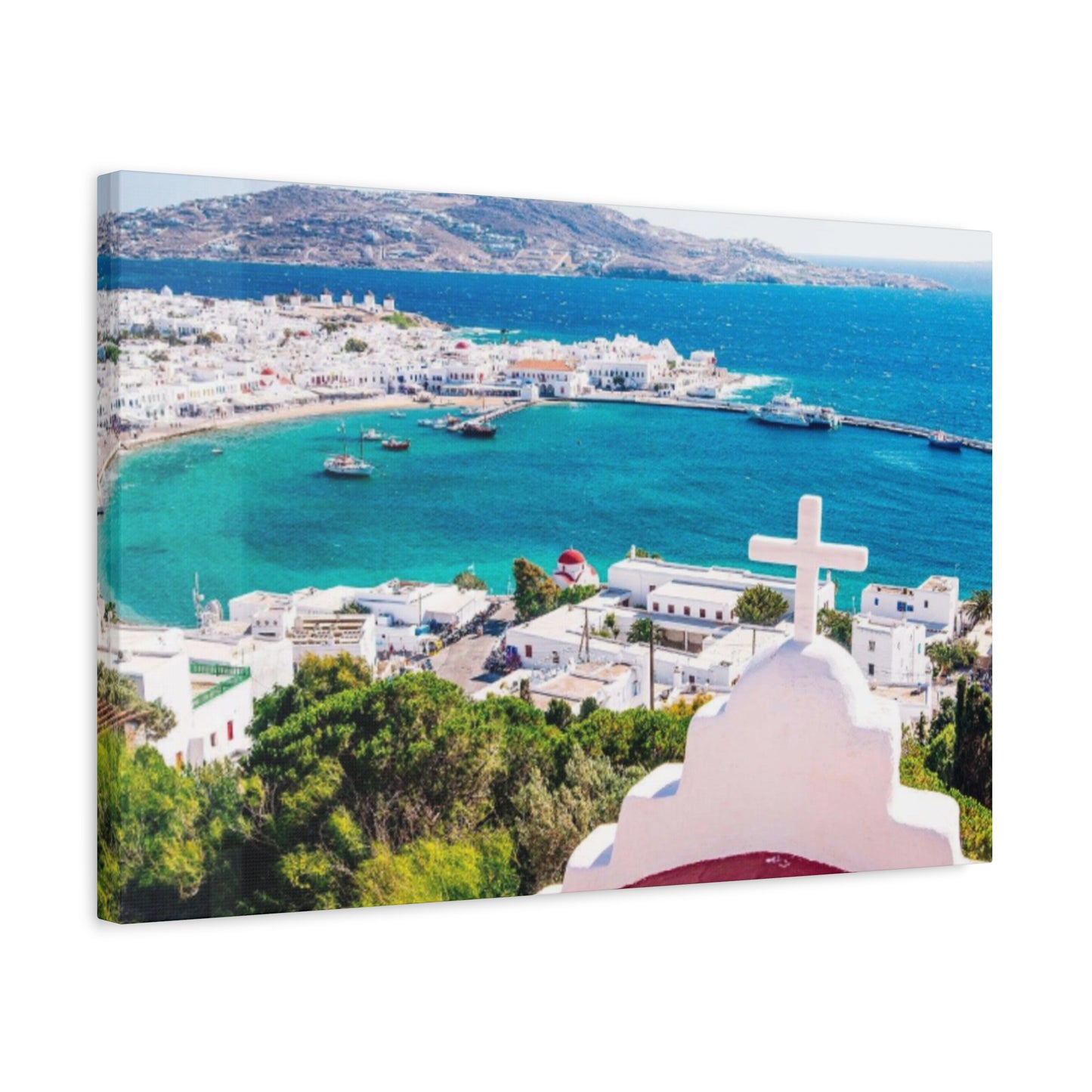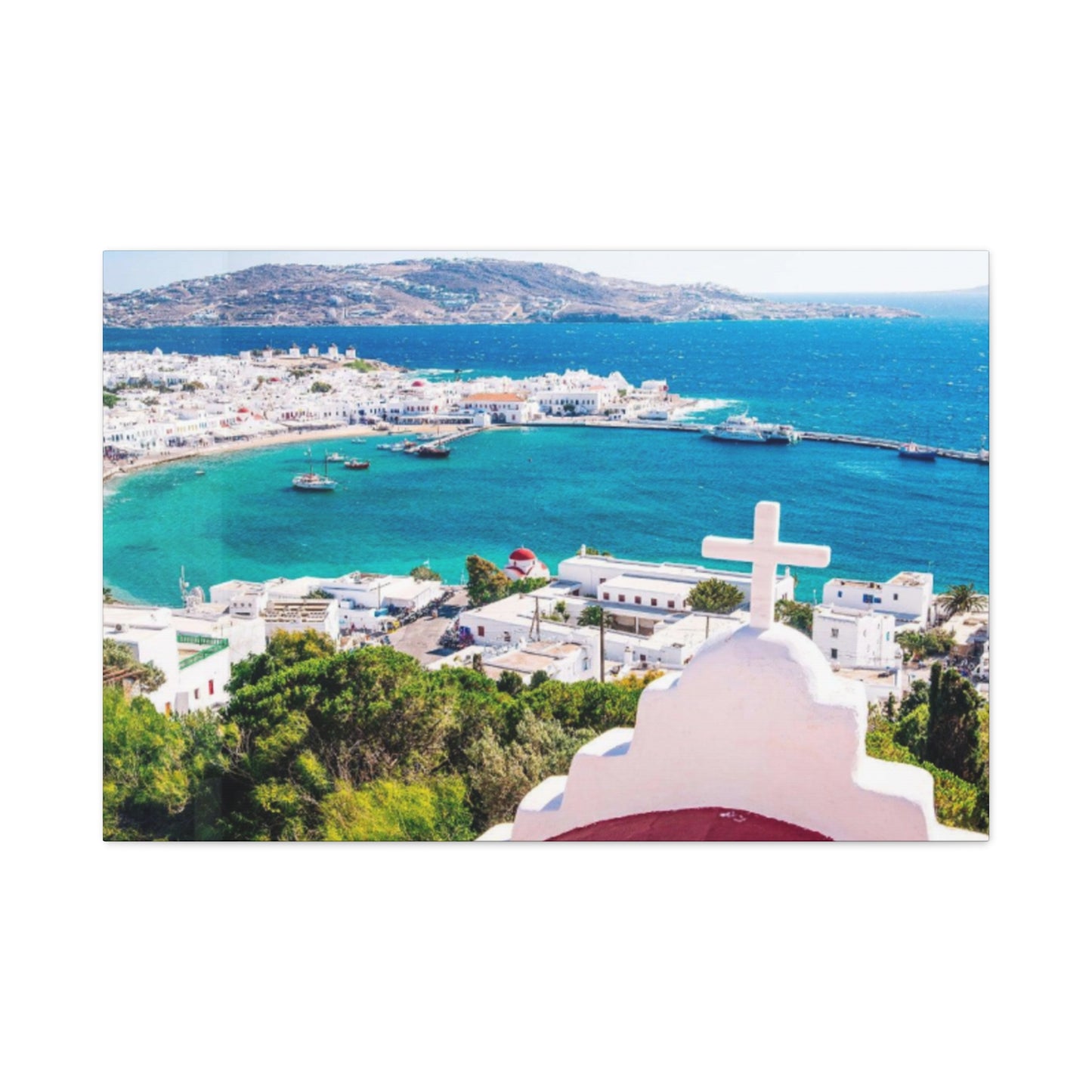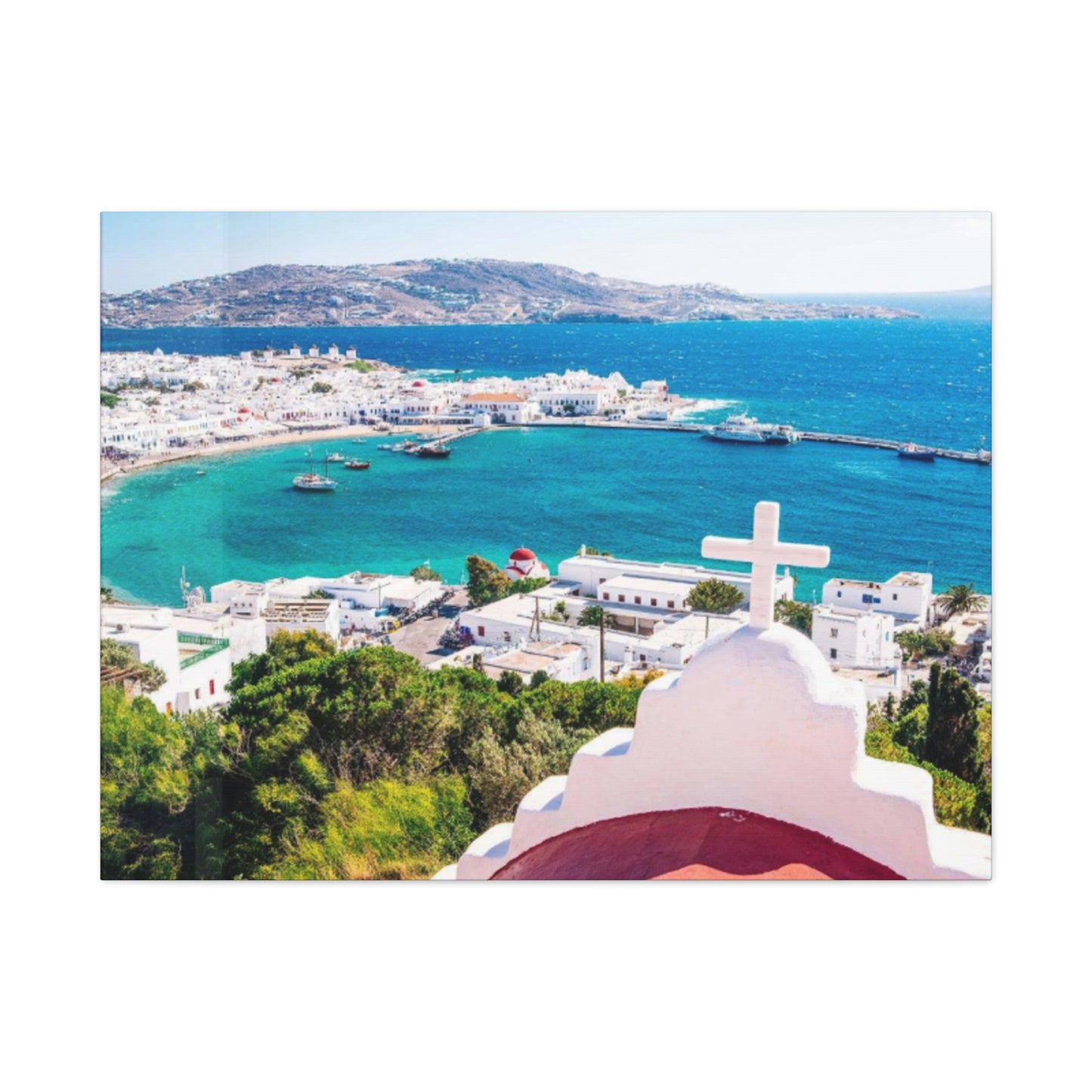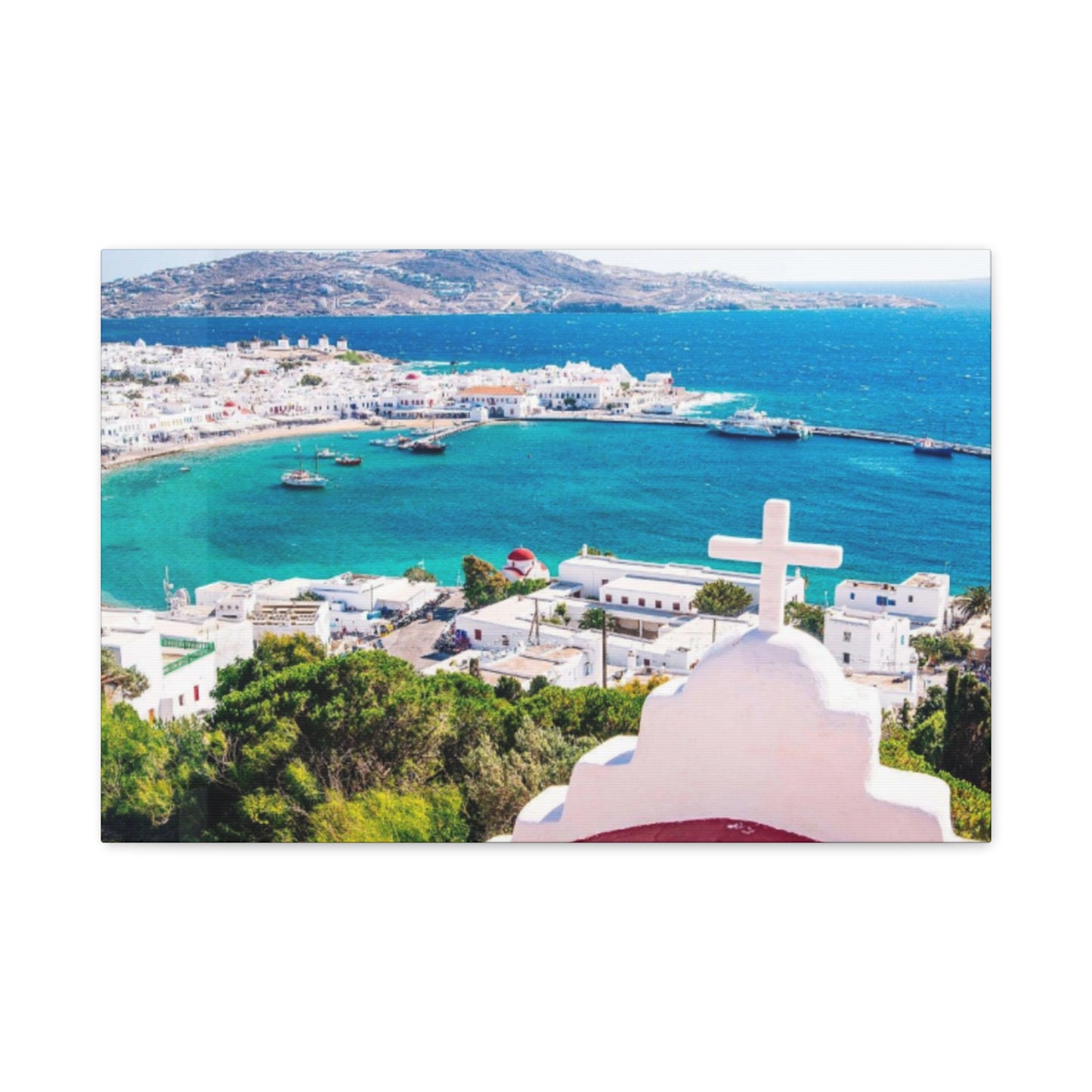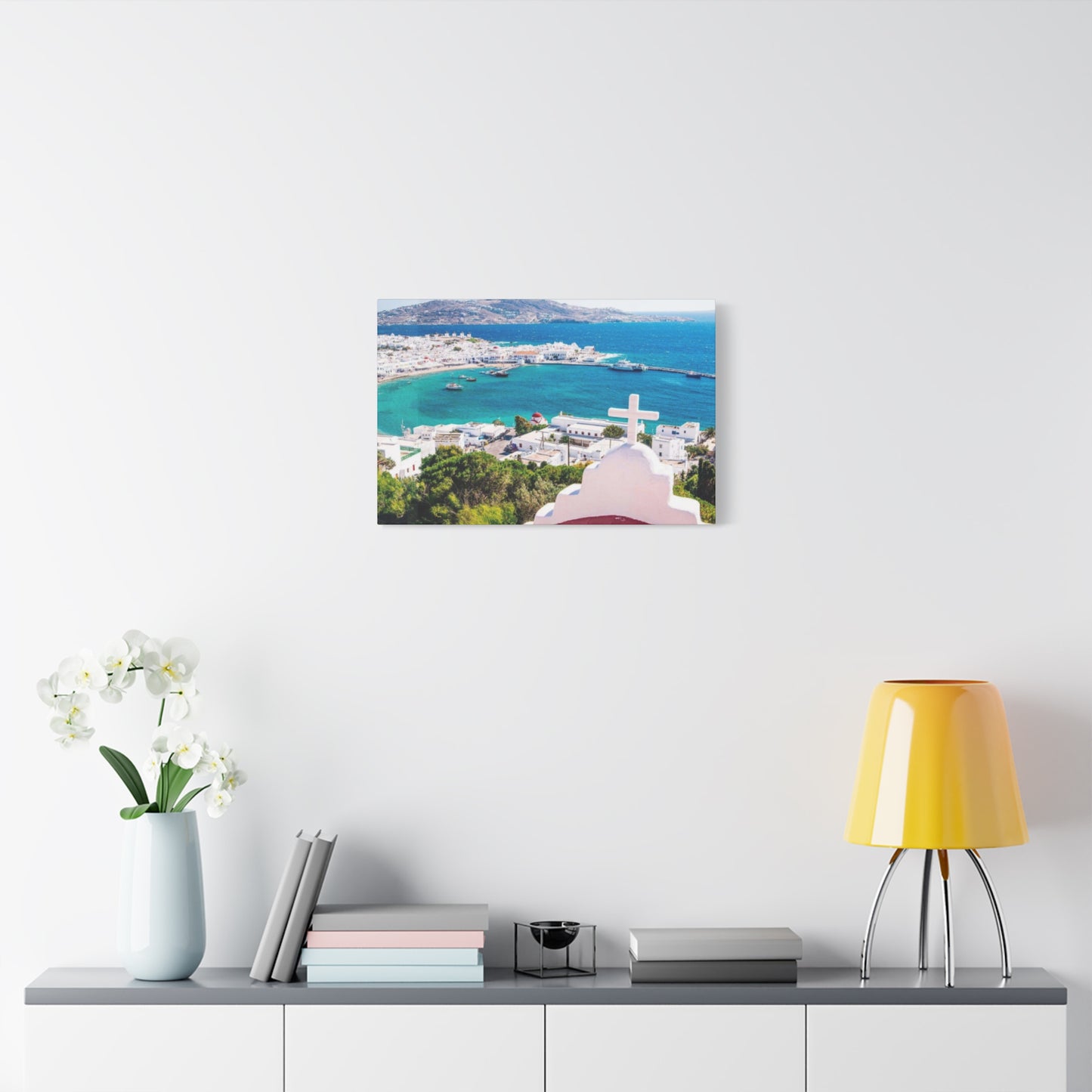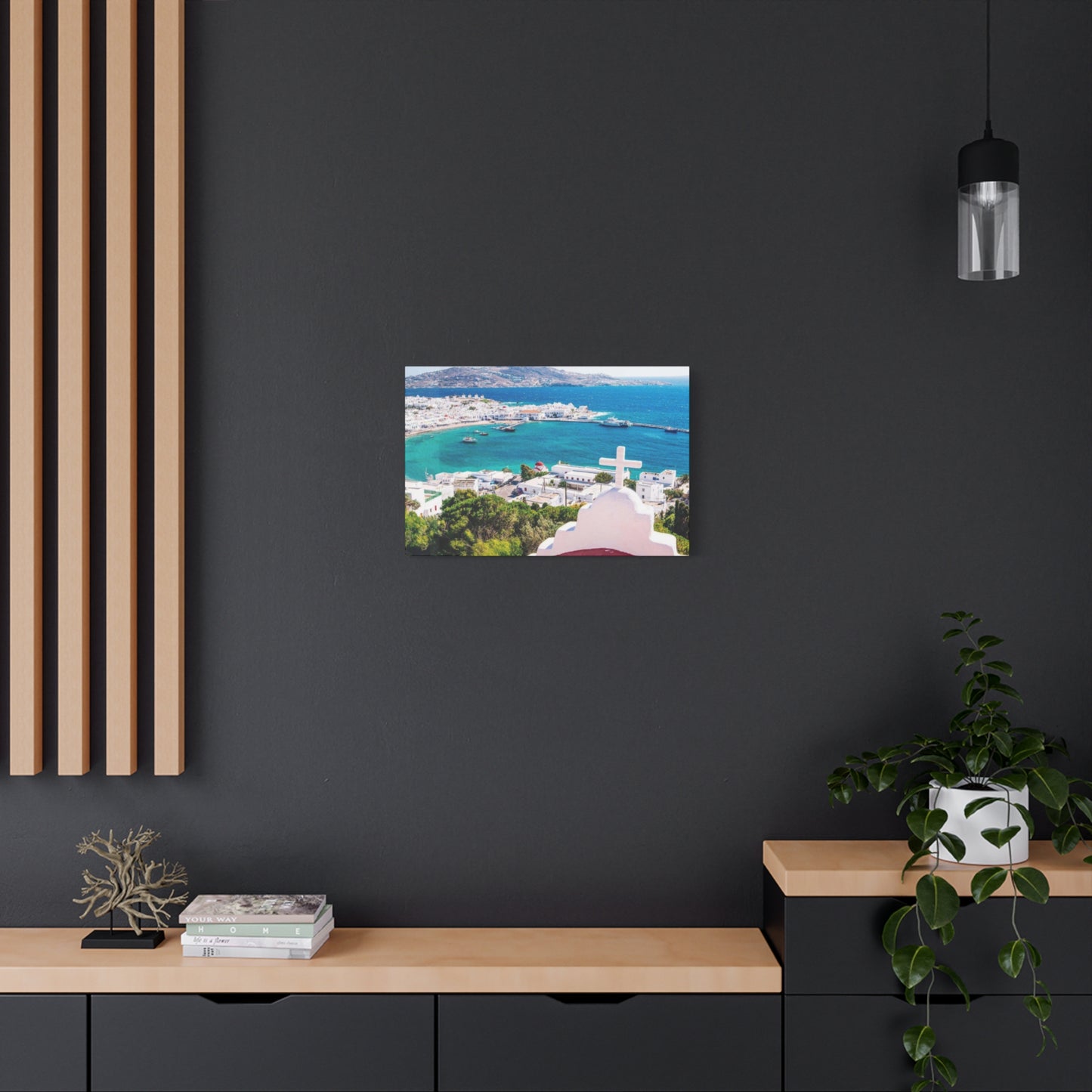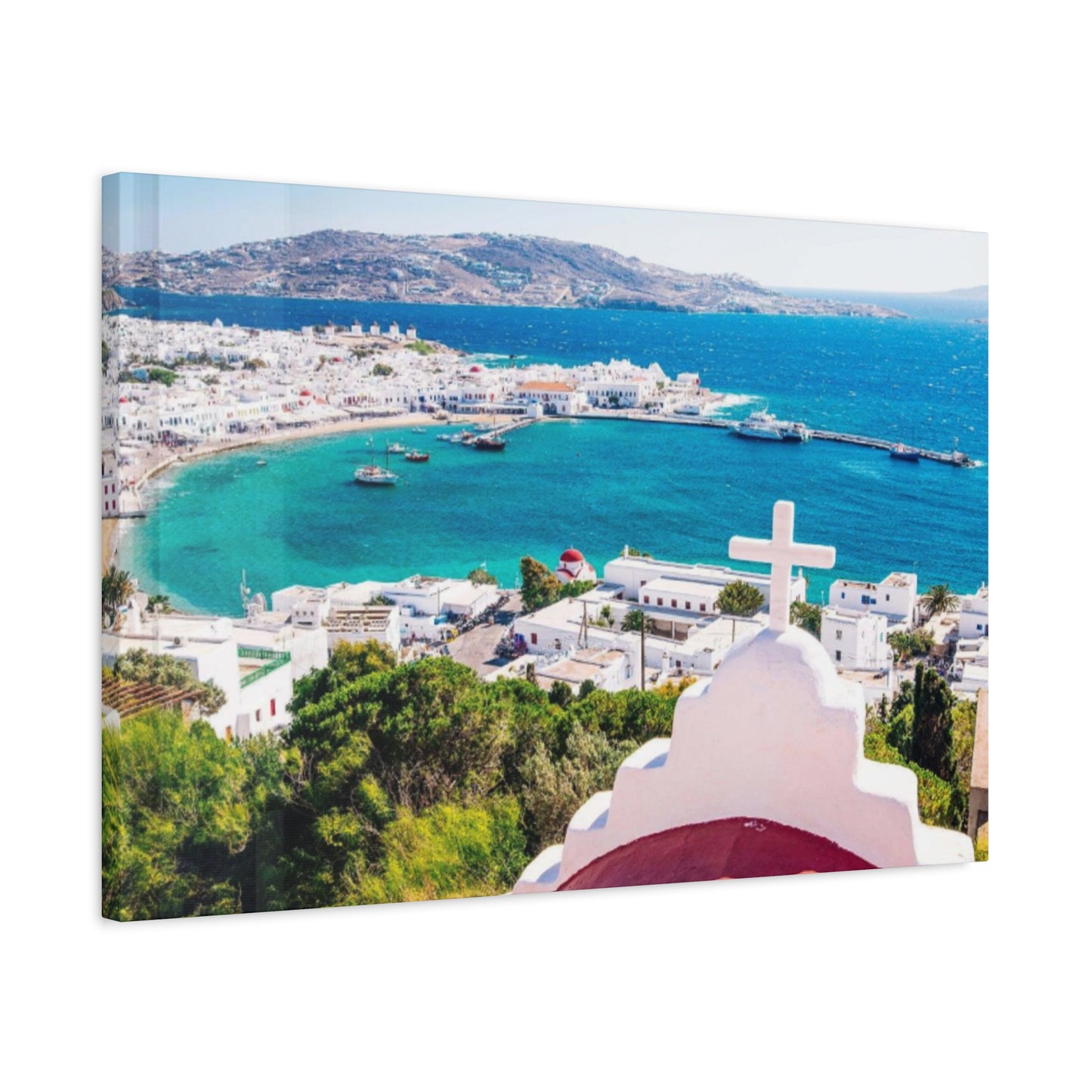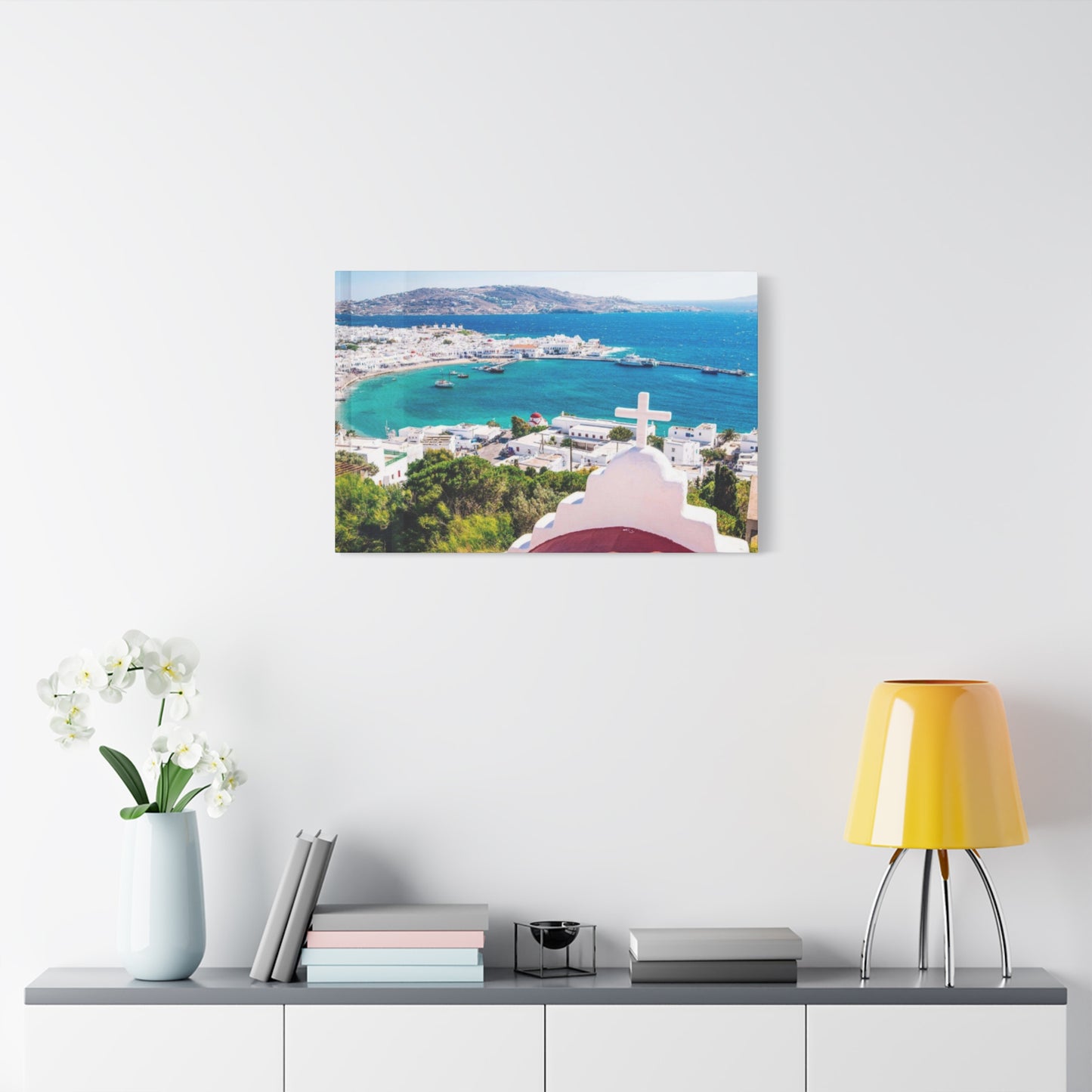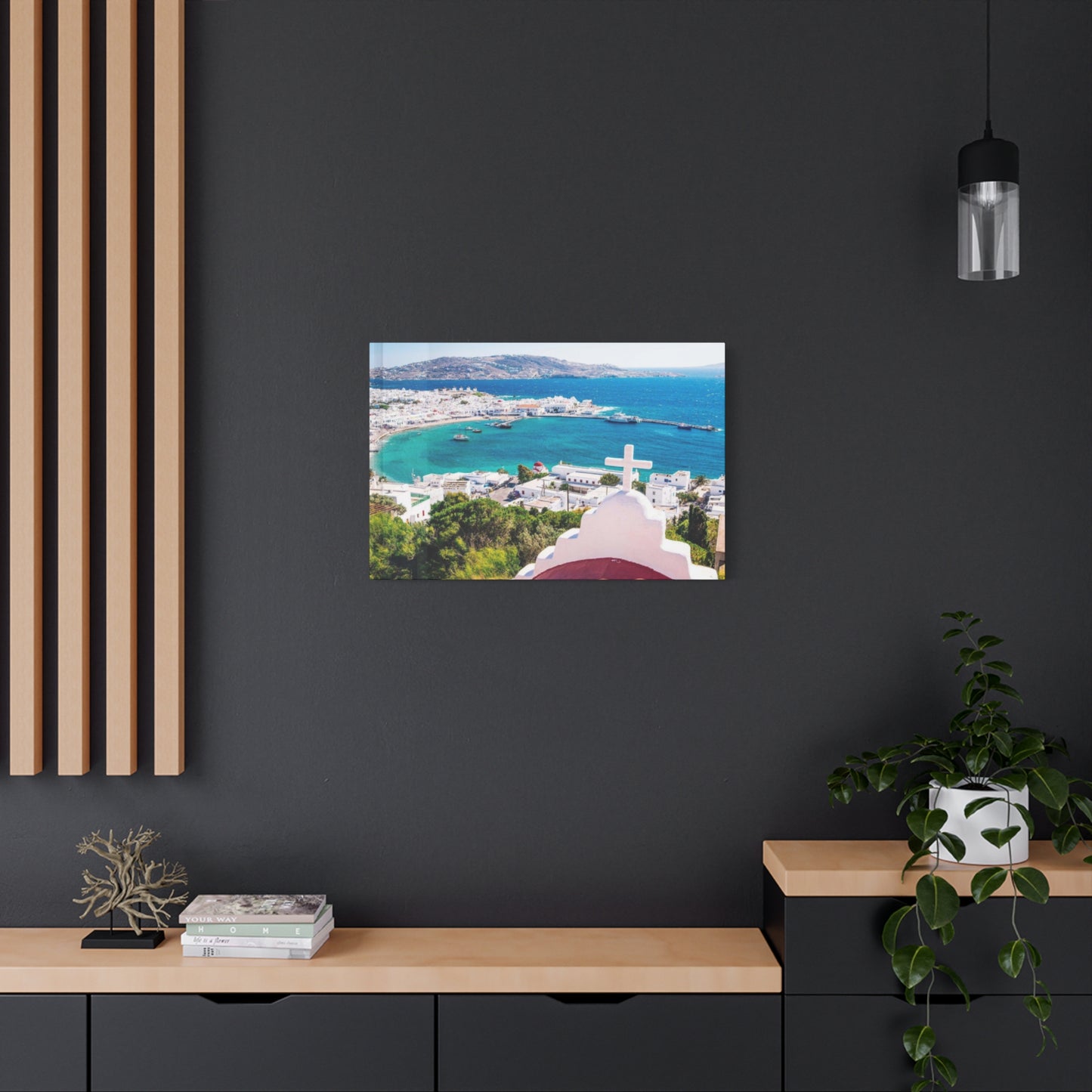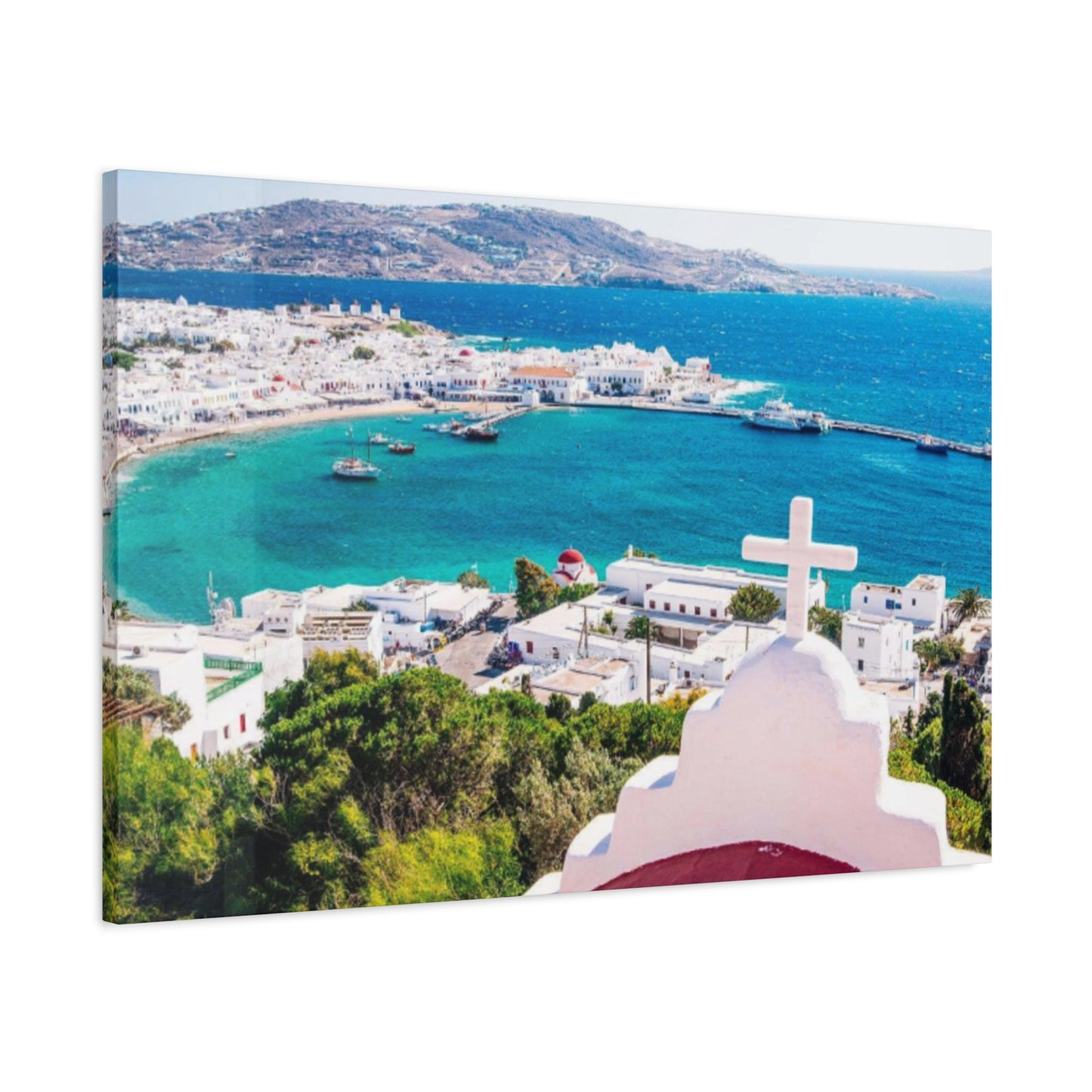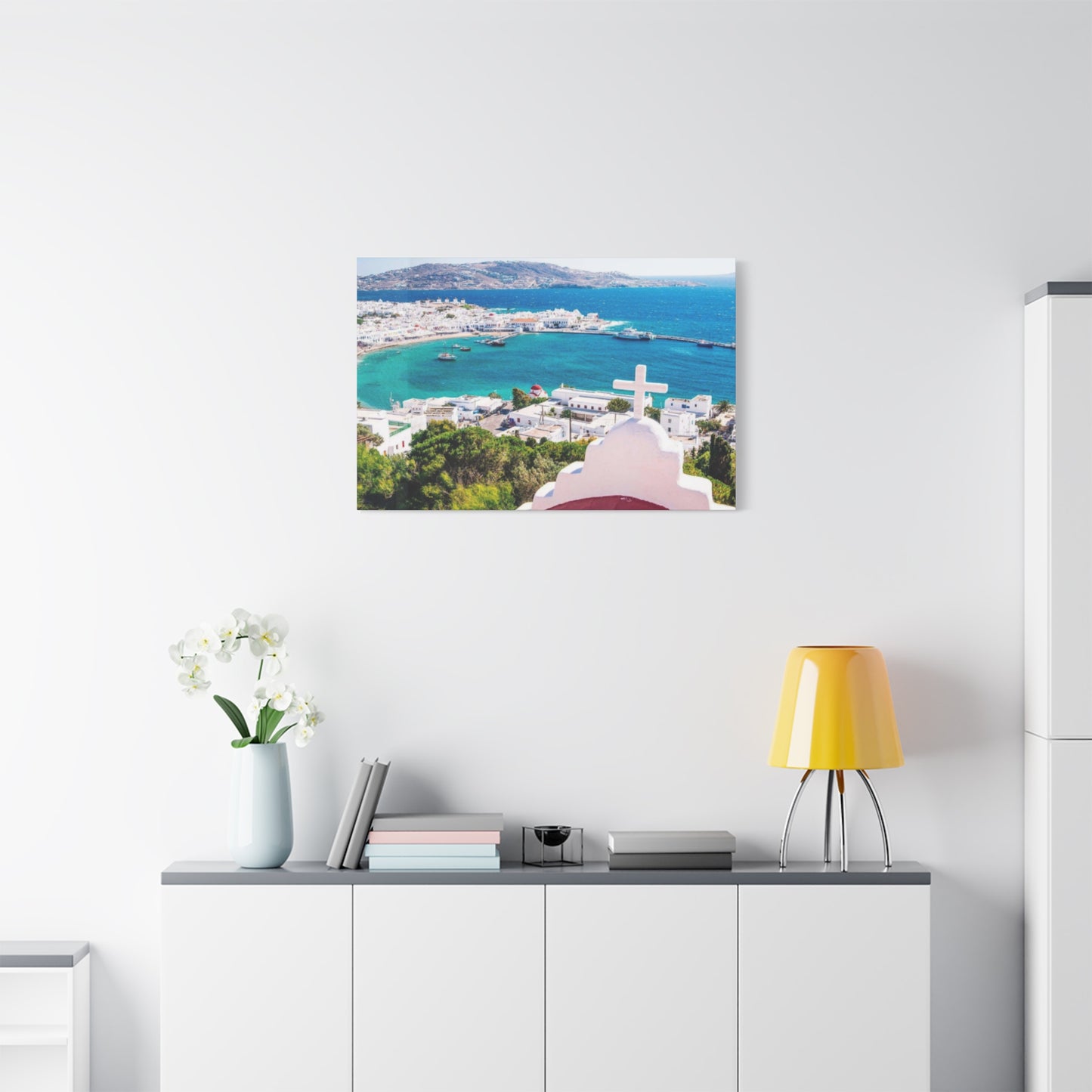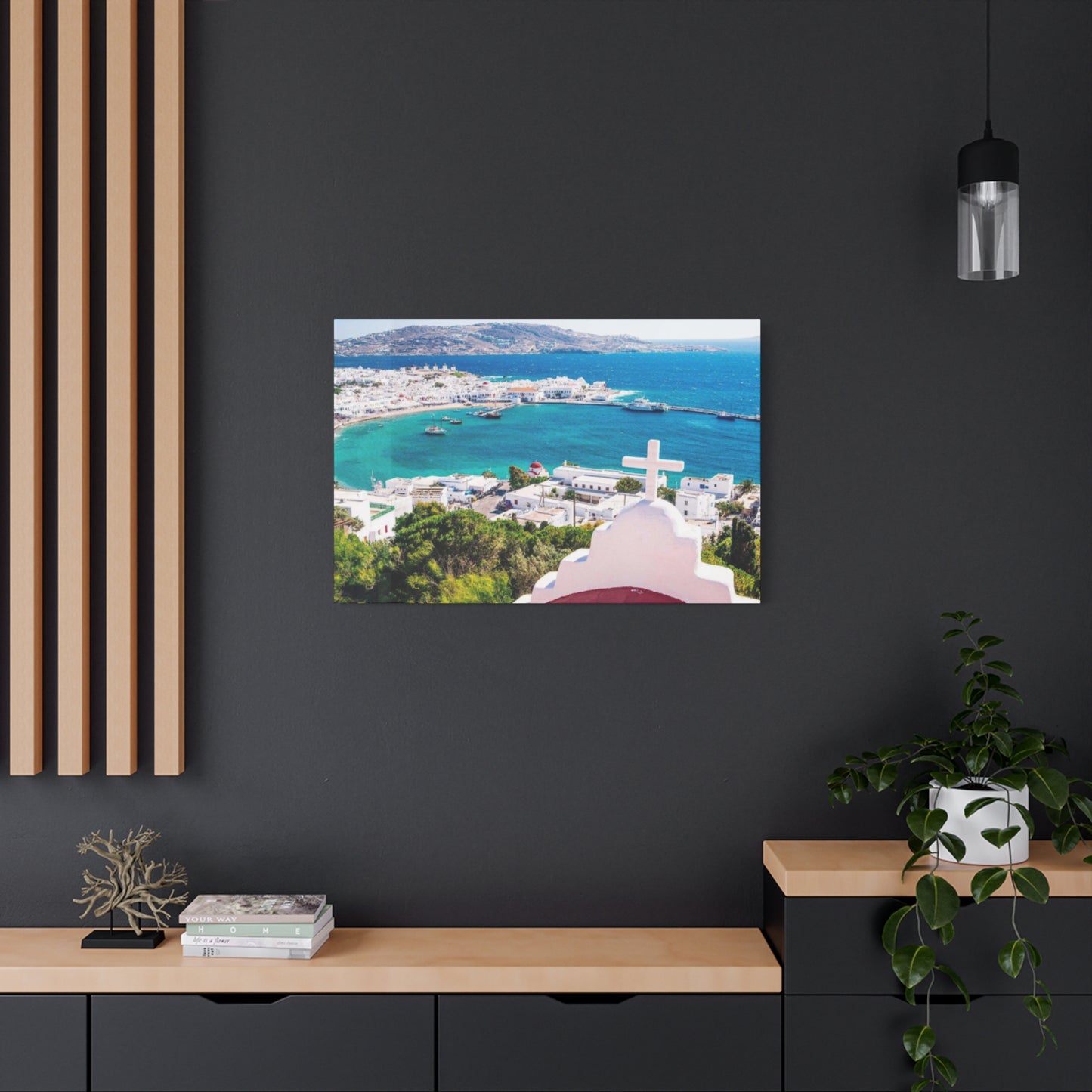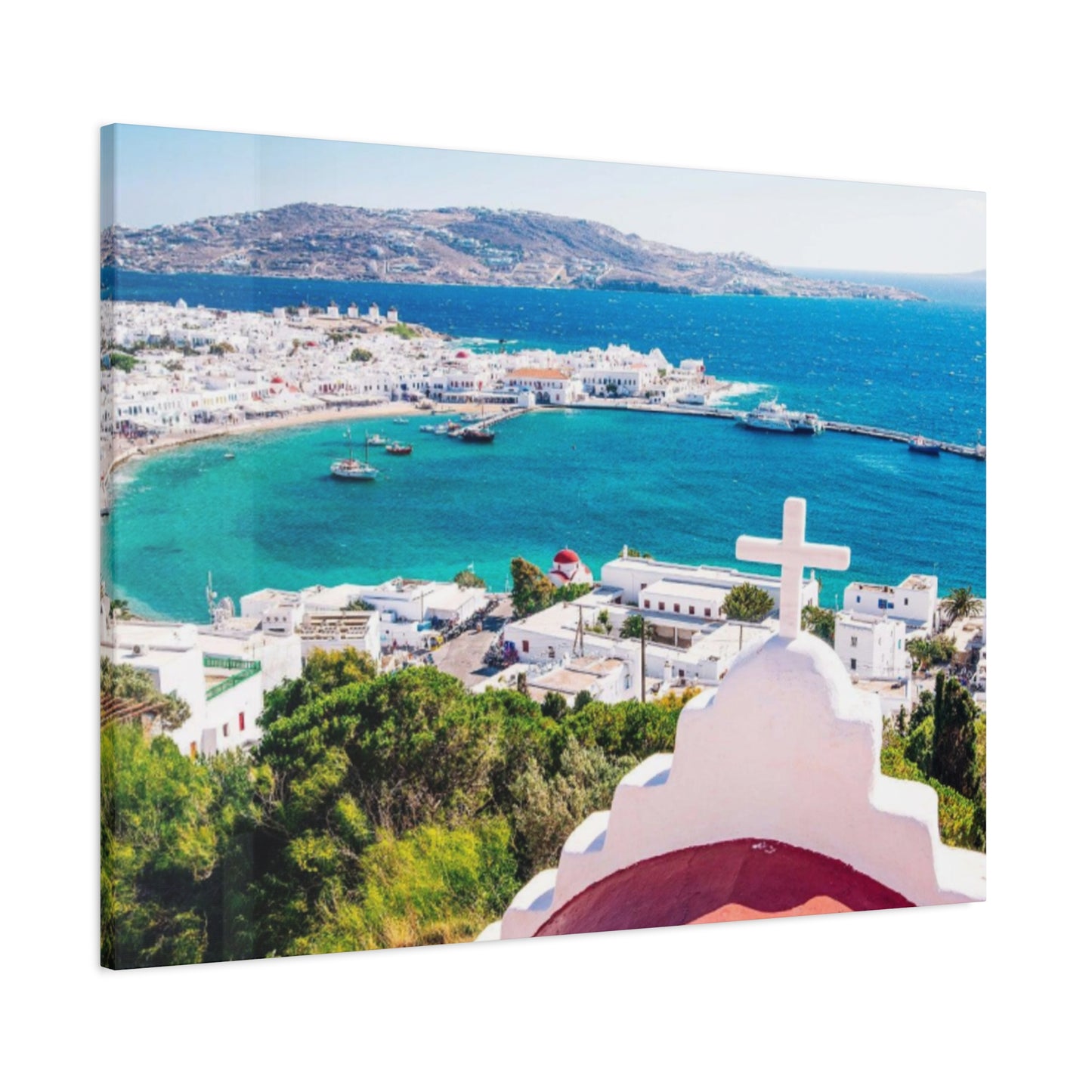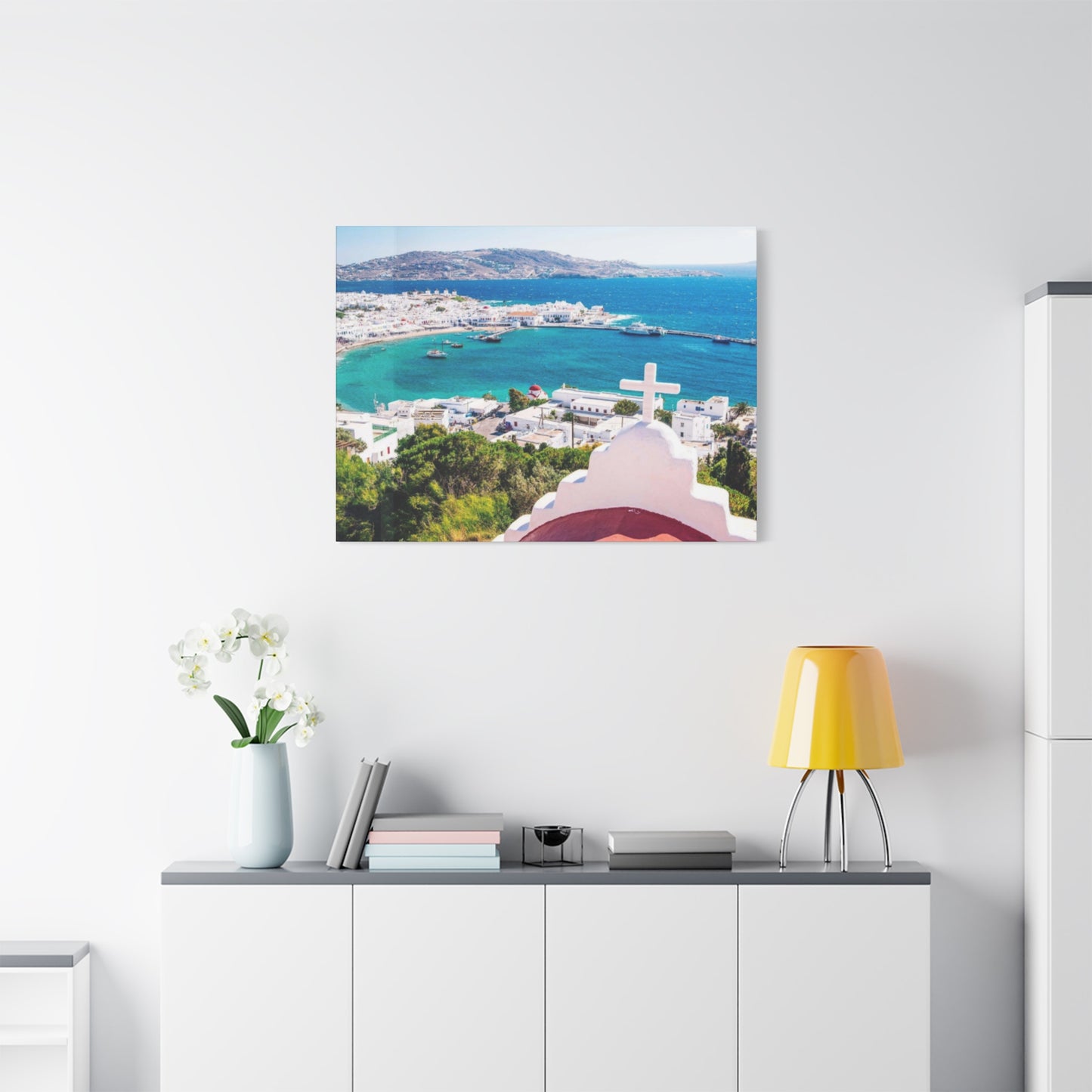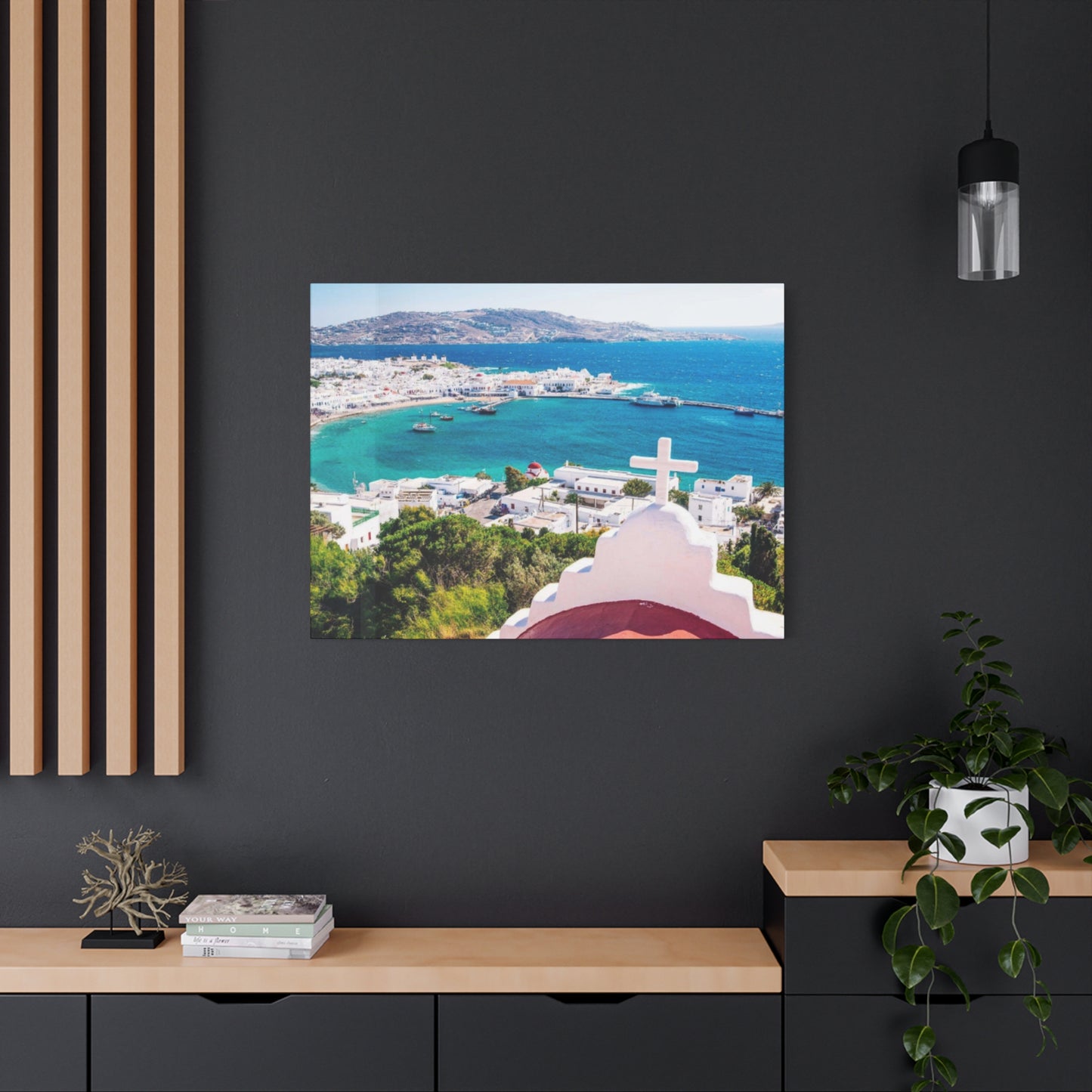Sacred Greece Church Wall Art: Transforming Homes with Divine Mediterranean Inspiration
Greece Orthodox churches stand as magnificent testaments to faith, artistry, and cultural heritage across the Mediterranean landscape. These sacred structures have inspired countless artists, photographers, and admirers throughout history, creating a rich tapestry of visual elements that translate beautifully into modern home decoration. The ethereal beauty of whitewashed chapels perched on clifftops, ancient stone monasteries nestled in mountainous terrain, and ornate cathedral domes piercing azure skies offers endless inspiration for those seeking to bring divine tranquility into their living environments.
The allure of Greece ecclesiastical architecture extends far beyond religious boundaries, captivating individuals from diverse backgrounds who appreciate the harmonious blend of Byzantine traditions, Mediterranean aesthetics, and spiritual symbolism. These sacred buildings represent more than mere structures; they embody centuries of devotion, artistic expression, and cultural continuity that resonates with contemporary audiences seeking meaningful decoration for their homes.
Modern homeowners increasingly turn to Greece church imagery as a source of inspiration for creating serene, contemplative environments that reflect both aesthetic sophistication and spiritual depth. The timeless appeal of these sacred structures lies in their ability to evoke feelings of peace, reverence, and connection to something greater than ourselves, making them perfect subjects for artistic interpretation in residential settings.
Discovering Sacred Atmospheres Through Greece Orthodox Photography
The spiritual ambiance surrounding Greece Orthodox churches creates an extraordinary photographic subject that captures the essence of divine contemplation and architectural grandeur. Professional photographers and enthusiasts alike are drawn to these sacred sites for their unique ability to convey both earthly beauty and heavenly aspiration through visual storytelling.
Greece Orthodox churches possess an inherent mystical quality that transcends their physical structures. The weathered stone facades tell stories of centuries past, while the pristine whitewashed walls reflect the Mediterranean sun with an almost supernatural brilliance. These contrasting elements create dynamic visual compositions that photographers can capture and transform into stunning artwork for residential display.
The positioning of Greece churches within their natural environments adds another layer of spiritual significance to photographic compositions. Many chapels stand as solitary sentinels on hilltops or coastal promontories, creating dramatic silhouettes against expansive skies. This isolation emphasizes the contemplative nature of these structures while providing photographers with opportunities to create powerful images that evoke solitude and reflection.
Seasonal variations in Greece church photography reveal different aspects of their spiritual character. Spring blossoms frame ancient doorways with delicate beauty, summer heat creates stark contrasts between shadow and brilliant light, autumn colors provide warm backdrops for weathered stone, and winter storms add dramatic intensity to coastal chapels. Each season offers unique opportunities for capturing the evolving relationship between sacred architecture and natural surroundings.
The human element in Greece church photography adds emotional depth to these spiritual compositions. Elderly worshippers ascending stone steps, flickering candles casting warm glows on ancient walls, and festival processions moving through village streets all contribute to the living narrative of faith that continues to unfold around these sacred structures. These moments of human interaction with divine architecture create compelling visual stories that resonate with viewers on both aesthetic and emotional levels.
Professional photographers working with Greece church subjects often emphasize the interplay between architectural details and spiritual symbolism. The intricate carvings adorning church entrances, the weathered texture of ancient stones, and the gentle curves of Byzantine domes all serve as visual metaphors for the intersection of human craftsmanship and divine inspiration.
Illumination Techniques for Highlighting Hellenic Sacred Architecture
Natural light plays a fundamental role in revealing the architectural magnificence of Greece Orthodox churches, transforming simple stone and mortar into ethereal compositions that seem to glow with inner radiance. The Mediterranean climate provides ideal conditions for capturing these sacred structures in their most flattering illumination, creating opportunities for photographers and artists to document their divine beauty.
The golden hour, occurring shortly after sunrise and before sunset, bathes Greece churches in warm, honey-colored light that enhances their spiritual atmosphere. During these magical moments, the low angle of sunlight creates dramatic shadows that accentuate architectural details while painting whitewashed walls with an almost supernatural glow. This natural illumination technique has been favored by artists for centuries as it reveals the three-dimensional qualities of church facades while maintaining the mysterious ambiance that makes these structures so compelling.
Backlighting techniques prove particularly effective when photographing Greece church silhouettes against brilliant Mediterranean skies. This approach creates powerful contrasts between the dark architectural forms and luminous backgrounds, emphasizing the spiritual significance of these structures as bridges between earth and heaven. The resulting images possess a timeless quality that translates beautifully into canvas prints and photographic artwork for home decoration.
The interplay between direct sunlight and shadow on Greece church surfaces creates natural chiaroscuro effects that rival the masterworks of Renaissance painters. Photographers can exploit these lighting conditions to highlight specific architectural elements, such as bell towers, entrance portals, or decorative stonework, while allowing other areas to recede into atmospheric shadow. This selective illumination technique draws viewers' attention to key compositional elements while maintaining the overall harmony of the image.
Overcast conditions offer different opportunities for capturing Greece church architecture in soft, even illumination that reveals subtle color variations and surface textures. The diffused light eliminates harsh shadows while maintaining sufficient contrast to define architectural forms clearly. These lighting conditions prove ideal for documenting the weathered patina of ancient stones and the delicate variations in whitewash that give each church its unique character.
Artificial lighting considerations become important when photographing Greece churches during evening hours or religious ceremonies. The warm glow of candles and electric illumination creates intimate atmospheres that contrast beautifully with the cool tones of twilight skies. These mixed lighting conditions require careful exposure techniques to maintain detail in both the illuminated architectural elements and the surrounding environment.
Harmonizing Greece Ecclesiastical Art with Mediterranean Cultural Elements
The integration of Greece Orthodox church art with traditional Mediterranean cultural elements creates rich, layered compositions that celebrate the interconnected nature of faith, culture, and regional identity. This artistic synthesis reflects the deep roots of Greece civilization and its continuing influence on contemporary aesthetic expression.
Traditional Greece decorative elements, such as geometric patterns derived from ancient pottery, olive branch motifs representing peace and abundance, and marine themes celebrating the nation's maritime heritage, complement ecclesiastical imagery beautifully. These cultural symbols enhance the narrative depth of church-inspired artwork while connecting viewers to the broader context of Greece civilization and its enduring values.
The color palette associated with traditional Greece culture provides an ideal foundation for displaying church-inspired artwork. The classic combination of brilliant white and deep blue, reminiscent of flag colors and Mediterranean seascapes, creates striking contrasts when paired with the warm earth tones often found in ecclesiastical architecture. These color relationships establish visual harmony while celebrating national identity through decorative choices.
Folk art traditions from various Greece regions offer complementary themes that enhance church-inspired decorations. The intricate embroidery patterns from island communities, the ceramic designs from pottery centers, and the metalwork traditions from mountain villages all share common roots with ecclesiastical art forms. Incorporating these elements creates comprehensive decorative schemes that honor the full spectrum of Greece cultural expression.
Seasonal celebrations and religious festivals provide additional opportunities for integrating church art with traditional cultural elements. Easter decorations featuring painted eggs and spring flowers complement images of decorated churches, while Christmas traditions incorporating olive wood nativity scenes enhance ecclesiastical themes. These seasonal connections create dynamic decorative programs that evolve throughout the year while maintaining thematic continuity.
The culinary traditions of Greece offer unexpected connections to ecclesiastical art through shared symbolic elements. Bread shapes used in religious ceremonies, the decorative presentation of festival foods, and the ritual significance of wine and olive oil all find echoes in church imagery and decoration. These connections create opportunities for comprehensive lifestyle approaches to Greece-inspired home decoration that extend beyond purely visual elements.
Regional variations in Greece cultural expression provide diverse approaches to combining church art with traditional elements. Island communities emphasize maritime themes and fishing traditions, mountain regions celebrate agricultural cycles and pastoral life, while urban centers blend ancient heritage with contemporary sophistication. Understanding these regional differences allows for more nuanced and authentic decorative approaches that honor specific cultural contexts.
Historical Narratives Behind Renowned Greece Orthodox Artistic Treasures
The artistic treasures adorning Greece Orthodox churches represent centuries of religious devotion, cultural exchange, and artistic innovation that have shaped not only the spiritual landscape of Greece but also influenced broader European artistic traditions. These masterpieces, ranging from ancient frescoes to contemporary icons, tell compelling stories of faith, perseverance, and creative expression that continue to inspire modern audiences.
Byzantine artistic traditions established the foundational aesthetic principles that continue to influence Greece Orthodox church decoration today. The distinctive iconographic style, with its emphasis on spiritual rather than naturalistic representation, created a visual language that communicates divine truths through symbolic imagery. These early masterpieces established precedents for color usage, compositional arrangement, and symbolic content that modern artists continue to reference and reinterpret.
The period of Ottoman rule presented significant challenges for Greece Orthodox artistic expression, yet many churches preserved their artistic treasures through the dedication of local communities and clergy. Hidden frescoes, concealed beneath later additions, have been rediscovered in recent decades, revealing the continuity of artistic traditions despite political upheaval. These recovered masterpieces provide invaluable insights into the evolution of Greece Orthodox art and its adaptation to changing historical circumstances.
Monastic communities played crucial roles in preserving and developing ecclesiastical artistic traditions throughout Greece history. The isolated locations of many monasteries provided safe havens for artists and craftsmen during periods of political instability, allowing for the continuation of artistic practices that might otherwise have been lost. The artistic schools associated with major monasteries, such as those on Mount Athos, developed distinctive styles that influenced church decoration throughout the Orthodox world.
The integration of Western European artistic influences during the post-Byzantine period created hybrid styles that combined traditional Orthodox iconographic principles with Renaissance and Baroque techniques. These synthetic approaches resulted in unique artistic expressions that reflected the complex cultural exchanges occurring in the Mediterranean region. The resulting artworks demonstrate the adaptability of Orthodox artistic traditions while maintaining their essential spiritual character.
Individual master artists whose works adorned Greece churches often remain anonymous, following the tradition of artistic humility associated with religious art. However, their distinctive styles and technical innovations can be traced through multiple church decorations, revealing the existence of artistic workshops and training systems that maintained high standards of craftsmanship across generations. These anonymous masters created visual legacies that continue to inspire contemporary artists and decorators.
The restoration and conservation of historic Greece church art has revealed previously unknown masterpieces while providing insights into ancient artistic techniques and materials. Modern scientific analysis of pigments, binding agents, and application methods has enhanced our understanding of how these artworks were created and how they can be preserved for future generations. This research has also informed contemporary artists seeking to recreate traditional techniques in modern contexts.
Refined Minimalism in Greece Orthodox Canvas Art Collections
The minimalist approach to Greece Orthodox church art represents a sophisticated aesthetic philosophy that emphasizes essential elements while eliminating unnecessary visual clutter. This refined approach appeals to contemporary sensibilities while maintaining the spiritual integrity and cultural authenticity of traditional ecclesiastical imagery.
Simplified compositions focusing on single architectural elements, such as a lone bell tower against a clear sky or a weathered church door framed by whitewashed walls, create powerful visual statements that embody the essence of Greece Orthodox architecture without overwhelming decorative environments. These pared-down images allow viewers to appreciate the inherent beauty of church design while providing flexible decorative options for various residential settings.
Color reduction techniques in minimalist Greece church art often focus on monochromatic or limited palette approaches that emphasize form and texture over chromatic complexity. Black and white photography of church subjects reveals the sculptural qualities of ecclesiastical architecture while creating timeless images that complement diverse decorative schemes. Similarly, limited color palettes featuring variations of blue and white or earth tones create cohesive series that work harmoniously in modern settings.
The elimination of extraneous visual elements in minimalist church art allows for greater focus on symbolic content and spiritual meaning. A simple cross silhouette, the gentle curve of a dome, or the weathered texture of ancient stone becomes the central focus of artistic composition, inviting contemplation and reflection. These simplified presentations often prove more powerful than complex compositions in conveying the essential spiritual message of church imagery.
Negative space plays a crucial role in minimalist Greece church art, with empty areas of canvas or photographic prints serving as visual breathing room that enhances the impact of architectural elements. This thoughtful use of empty space creates balance and harmony while preventing visual overcrowding in residential environments. The resulting artworks integrate seamlessly into contemporary decorative schemes without competing for attention with other design elements.
Scale considerations in minimalist church art require careful attention to ensure that simplified compositions maintain their visual impact when displayed in residential environments. Large format prints of single architectural details can create dramatic focal points, while series of smaller minimalist images can be arranged to create comprehensive decorative programs. The key lies in matching the scale of the artwork to the intended display environment while preserving the essential character of the original subject.
The philosophical underpinnings of minimalist Greece church art align with broader contemporary movements toward simplicity and mindfulness in home decoration. By focusing on essential elements and eliminating visual distractions, these artworks create opportunities for contemplation and spiritual reflection that enhance the quality of daily life. This alignment with contemporary values makes minimalist church art particularly appealing to modern audiences seeking meaningful decoration that supports personal well-being.
Ancient Frescoes and Their Contemporary Artistic Influence
The magnificent frescoes adorning Greece Orthodox churches represent one of the most enduring and influential art forms in Western civilization, with techniques and imagery that continue to inspire contemporary artists and decorators. These monumental paintings, executed on wet plaster surfaces, have survived for centuries, testament to both their technical excellence and spiritual significance.
Byzantine fresco techniques developed sophisticated approaches to color mixing, surface preparation, and artistic execution that enabled these artworks to maintain their vibrancy and integrity across millennia. Modern artists studying these ancient methods have rediscovered traditional pigments and application techniques that can be adapted for contemporary artistic projects. The knowledge gained from analyzing historic frescoes has informed new approaches to creating artwork that captures the timeless qualities of traditional ecclesiastical painting.
Iconographic programs in Greece church frescoes follow carefully established theological and artistic principles that create comprehensive visual narratives spanning entire church buildings. These systematic approaches to decorative planning provide valuable models for contemporary artists and decorators seeking to create cohesive artistic programs for residential and commercial environments. The hierarchical arrangement of subjects, the careful consideration of viewing angles, and the integration of architectural elements all offer lessons applicable to modern decorative projects.
Color symbolism in traditional Greece frescoes employs specific hues to convey theological concepts and emotional responses, creating sophisticated color programs that enhance the spiritual impact of ecclesiastical art. Understanding these color relationships enables contemporary artists to create artwork that resonates with viewers on subconscious levels while maintaining connection to traditional artistic wisdom. The deep blues representing divine truth, the warm golds symbolizing heavenly light, and the earth tones connecting human experience to natural cycles all provide inspiration for modern color palette development.
Technical innovations in fresco restoration have revealed previously hidden layers of artistic decoration, exposing the evolution of church art across different historical periods. These archaeological discoveries have provided unprecedented insights into artistic methods and materials while revealing the continuous development of ecclesiastical decorative programs. Contemporary artists can draw inspiration from these revealed layers, incorporating elements from different periods to create artwork that reflects the rich historical depth of Greece Orthodox artistic traditions.
The adaptation of fresco imagery for contemporary decorative applications requires careful consideration of scale, context, and cultural sensitivity. Modern printing techniques can reproduce the subtle color variations and textural qualities of ancient frescoes while making these images accessible for residential display. However, successful adaptation requires understanding the original cultural and spiritual context of these artworks to ensure that contemporary interpretations maintain appropriate respect for their sacred origins.
Educational programs focused on Greece fresco techniques have emerged in art schools and cultural institutions worldwide, creating new generations of artists versed in traditional methods and contemporary applications. These programs combine historical research with practical training, enabling students to understand both the technical aspects and cultural significance of fresco painting. The resulting knowledge base supports continued innovation in ecclesiastical art while preserving traditional skills and techniques.
Cultivating Tranquility and Contemplation Through Sacred Art
The power of Greece Orthodox church art to inspire peace and reflection stems from its fundamental purpose as a conduit for spiritual experience and divine contemplation. These artistic expressions, rooted in centuries of religious tradition and cultural wisdom, possess inherent qualities that promote mental calm and emotional equilibrium in contemporary living environments.
Psychological research has demonstrated the positive effects of sacred art on mental well-being, showing measurable reductions in stress levels and improvements in mood among individuals exposed to religious imagery. Greece church art, with its emphasis on harmony, proportion, and spiritual symbolism, proves particularly effective in creating therapeutic environments that support personal growth and emotional healing. The contemplative qualities inherent in these artistic expressions make them valuable tools for creating restorative home environments.
Color therapy principles align closely with traditional Greece Orthodox artistic practices, as the blues, whites, and earth tones commonly found in church imagery have documented calming effects on human psychology. The predominant blue tones associated with Greece church art promote feelings of tranquility and trust, while the white elements suggest purity and clarity of thought. These color relationships create naturally soothing environments that support relaxation and meditation.
Symbolic content in Greece church art provides focal points for contemplative practice, offering viewers meaningful imagery that can serve as subjects for meditation and reflection. The cross, representing sacrifice and redemption, the olive branch symbolizing peace and reconciliation, and the dove conveying divine presence all provide universally resonant symbols that transcend religious boundaries. These archetypal images tap into collective unconscious patterns that promote psychological integration and spiritual growth.
Environmental psychology studies have shown that artwork depicting natural and architectural subjects, such as Greece churches in landscape settings, can reduce mental fatigue and improve cognitive function. The combination of architectural order and natural beauty found in Greece church art creates balanced compositions that satisfy both the human need for structure and the desire for connection with natural environments. This dual appeal makes church-inspired art particularly effective in creating harmonious living environments.
The meditative qualities of Greece church art can be enhanced through thoughtful display techniques that create dedicated contemplation areas within residential environments. Proper lighting, appropriate framing, and strategic positioning all contribute to the effectiveness of sacred art in promoting reflection and spiritual awareness. These considerations transform ordinary living areas into sanctuaries that support personal growth and emotional well-being.
Seasonal variations in displaying Greece church art can create dynamic contemplative programs that evolve throughout the year while maintaining thematic continuity. Spring displays might emphasize resurrection and renewal themes, summer arrangements could focus on abundance and celebration, autumn presentations might explore harvest and gratitude concepts, while winter displays could emphasize contemplation and preparation. These cyclical approaches create living decorative programs that support ongoing spiritual development.
Integrating Hellenic Sacred Art in Modern Living Environments
The successful incorporation of Greece Orthodox church art into contemporary residential environments requires careful consideration of architectural context, decorative harmony, and cultural sensitivity. Modern homes can benefit significantly from the timeless beauty and spiritual depth of ecclesiastical imagery when these elements are thoughtfully integrated into existing design schemes.
Contemporary architectural styles, from minimalist modernism to transitional eclecticism, can accommodate Greece church art through various presentation approaches that honor both the artwork's sacred origins and the homeowner's aesthetic preferences. Clean-lined modern environments provide neutral backdrops that allow church imagery to command attention without competing visual elements, while more traditional settings can integrate ecclesiastical art as part of comprehensive cultural themes.
Scale considerations play crucial roles in successfully incorporating church art into residential environments, as the monumental nature of ecclesiastical architecture must be adapted to intimate home settings. Large format prints of church exteriors can create dramatic focal points in living areas, while smaller intimate images work well in bedrooms and private study areas. Series arrangements allow for comprehensive programs that can be distributed throughout homes to create thematic continuity without overwhelming individual rooms.
Lighting design significantly impacts the effectiveness of church art in contemporary settings, as proper illumination can enhance the spiritual qualities of ecclesiastical imagery while integrating seamlessly with functional residential lighting systems. Picture lighting, accent spots, and natural illumination all play roles in creating optimal viewing conditions that honor the artwork while serving practical needs. The warm light traditionally associated with church interiors can be replicated through careful fixture selection and lamp choice.
Material considerations in framing and mounting Greece church art require attention to conservation principles while meeting contemporary aesthetic expectations. Museum-quality materials ensure long-term preservation of valuable prints and photographs, while frame selections should complement both the artwork and the surrounding decorative environment. Traditional materials such as wood and metal honor the cultural context of church art, while contemporary materials can create interesting juxtapositions that highlight the timeless relevance of ecclesiastical imagery.
Cultural sensitivity remains paramount when displaying Greece church art in residential settings, as these images carry deep spiritual significance that must be respected regardless of the viewer's personal religious beliefs. Appropriate placement, reverent presentation, and respectful discussion of the artwork's cultural context all contribute to successful integration that honors the sacred origins of these artistic expressions. This respectful approach ensures that church art enhances rather than compromises the spiritual integrity of the home environment.
The educational value of Greece church art in contemporary homes provides opportunities for cultural enrichment and historical awareness that benefit all family members. These artistic expressions serve as windows into Greece culture, Orthodox theology, and Mediterranean history, creating conversation starters and learning opportunities that enhance the intellectual atmosphere of home environments. This educational dimension adds depth and meaning to decorative choices while supporting lifelong learning goals.
Orthodox Symbolism in Contemporary Visual Arts
The enduring power of Greece Orthodox crosses in contemporary visual arts reflects their status as universal symbols of faith, hope, and divine love that transcend specific religious boundaries to communicate fundamental human values. These sacred symbols have inspired countless artistic interpretations that maintain their spiritual significance while exploring new aesthetic possibilities.
Traditional Greece Orthodox cross designs incorporate distinctive proportions and decorative elements that differentiate them from Western Christian crosses while maintaining the essential symbolic meaning of sacrifice and redemption. The equal-armed Greece cross, the ornate Byzantine cross with decorative endings, and the simple wooden crosses found in rural chapels all provide inspiration for contemporary artists seeking to create meaningful spiritual imagery. These traditional forms can be adapted and reinterpreted while preserving their essential symbolic content.
Contemporary artists working with Orthodox cross imagery often explore the tension between ancient symbolism and modern aesthetic sensibilities, creating hybrid works that honor traditional meanings while speaking to contemporary audiences. Abstract interpretations that suggest rather than literally depict cross forms can convey spiritual concepts through color, line, and composition without explicit religious imagery. These subtle approaches make sacred symbolism accessible to diverse audiences while maintaining respect for the original spiritual content.
Material innovations in creating contemporary cross art have expanded beyond traditional media to include modern materials such as metal, glass, and composite substances that offer new possibilities for artistic expression. These contemporary materials can create striking visual effects while maintaining the essential symbolic power of cross imagery. However, successful innovation requires understanding the traditional associations between materials and spiritual meaning to ensure that new interpretations enhance rather than diminish the symbol's impact.
Cultural fusion in cross-inspired art reflects the global nature of contemporary artistic practice, as artists from diverse backgrounds incorporate Orthodox cross imagery into their work while bringing their own cultural perspectives to bear on these universal symbols. These cross-cultural interpretations create rich artistic dialogues that explore common spiritual themes while celebrating cultural diversity. The resulting artworks often reveal unexpected connections between different religious and cultural traditions.
Therapeutic applications of cross imagery in contemporary art therapy and spiritual counseling demonstrate the continuing psychological power of these ancient symbols to promote healing and personal growth. The cross serves as a focal point for meditation and reflection, providing a stable reference point for individuals seeking spiritual grounding in challenging circumstances. This therapeutic dimension of cross imagery makes it particularly valuable in creating supportive home environments.
Environmental applications of cross imagery in landscape and architectural contexts create opportunities for public art installations that serve both aesthetic and spiritual functions. Contemporary artists have created large-scale cross installations in natural settings that complement landscape features while providing focal points for contemplation and reflection. These environmental works demonstrate the versatility of cross symbolism while creating meaningful connections between artistic expression and natural settings.
Historical Greece Church Posters and Their Artistic Merit
The vintage poster tradition celebrating Greece Orthodox churches represents a unique intersection of commercial art, cultural promotion, and spiritual expression that has created a distinctive body of graphic design with significant artistic and historical value. These promotional materials, created primarily during the mid-twentieth century tourism boom, captured the romantic appeal of Greece ecclesiastical architecture while serving practical marketing purposes.
Travel poster aesthetics from the golden age of tourism promotion employed sophisticated graphic design techniques to distill the essence of Greece church architecture into compelling visual summaries that could attract international visitors. These posters typically featured bold color schemes, simplified architectural forms, and romanticized landscape settings that emphasized the exotic appeal of Greece destinations while maintaining recognizable architectural accuracy. The artistic challenge of conveying complex architectural beauty through simplified graphic elements resulted in design innovations that continue to influence contemporary poster art.
Typography in vintage Greece church posters often incorporated elements derived from Byzantine manuscript traditions, classical Greece letterforms, and contemporary modernist design principles to create distinctive textual presentations that complemented the architectural imagery. These typographic approaches balanced historical authenticity with contemporary readability, resulting in design solutions that honored cultural heritage while meeting practical communication needs. The integration of text and image in these posters provides valuable lessons for contemporary graphic designers working with cultural themes.
Color psychology in vintage poster design reflected both the natural palette of Greece landscapes and the psychological associations that designers sought to create in potential visitors. The predominant blues suggesting Mediterranean seas and skies, the warm whites of traditional architecture, and the golden tones representing abundant sunshine all combined to create visual experiences that promised escape from industrial urban environments. These color strategies remain effective in contemporary applications of Greece church imagery.
Artistic techniques employed in creating vintage church posters included hand-illustration, photographic manipulation, and hybrid approaches that combined realistic architectural documentation with stylized graphic interpretation. These varied approaches resulted in diverse visual styles that reflected different artistic sensibilities while maintaining thematic consistency around ecclesiastical subjects. The technical limitations of historical printing processes often produced distinctive visual qualities that contemporary designers seek to emulate using digital techniques.
Cultural documentation provided by vintage Greece church posters offers valuable insights into changing perceptions of Greece culture and tourism promotion strategies across different historical periods. These promotional materials reflect evolving attitudes toward cultural authenticity, commercial appropriation of religious imagery, and the commodification of spiritual experiences for tourist consumption. Understanding these historical contexts provides important perspectives for contemporary artists and designers working with similar themes.
Collectible value of vintage Greece church posters has increased significantly as interest in mid-century graphic design and travel memorabilia has grown among collectors and interior decorators. The combination of artistic merit, historical significance, and decorative appeal makes these posters attractive investments that can enhance home environments while appreciating in monetary value. The scarcity of original examples and the quality of graphic design contribute to their continuing market appeal.
Religious Festival Celebrations in Greece Artistic Traditions
The vibrant celebrations of Greece Orthodox festivals provide rich source material for contemporary artists seeking to capture the intersection of sacred and secular cultural expression that characterizes Greece religious life. These annual celebrations combine ancient theological traditions with regional customs and community festivities, creating complex cultural events that inspire diverse artistic interpretations.
Easter celebrations in Greece offer particularly compelling subjects for artistic documentation, as the combination of solemn religious observance and joyous community celebration creates dramatic contrasts that translate effectively into visual art. The midnight resurrection service, with its explosion of light and sound after the quiet darkness of Good Friday, provides powerful imagery that can be captured through photography, painting, and digital art. The decorative traditions associated with Easter, including painted eggs, flower arrangements, and traditional breads, add colorful details that enhance the visual appeal of festival-inspired artwork.
Christmas observances in Greece Orthodox communities blend Byzantine theological traditions with regional folk customs to create distinctive celebratory atmospheres that differ from Western Christmas traditions while maintaining universal themes of divine incarnation and human joy. The forty-day Advent preparation period, with its emphasis on fasting and spiritual preparation, culminates in twelve days of celebration that provide numerous opportunities for artistic documentation. The integration of natural elements such as olive branches, seasonal fruits, and traditional crafts creates rich visual textures that enhance festival-inspired art.
Regional variations in festival celebrations reflect the diverse cultural heritage of different Greece communities, from the maritime traditions of island communities to the agricultural customs of mountain villages. These local adaptations of universal religious themes create opportunities for artists to explore the relationship between faith and culture while celebrating the distinctive characteristics of particular communities. Understanding these regional differences enables more authentic and meaningful artistic interpretations of festival traditions.
Processional elements in Greece religious festivals, including icon processions, ceremonial banners, and community parades, create dynamic visual sequences that challenge artists to capture movement and temporal progression within static media. The combination of formal religious elements with spontaneous community participation generates complex compositional challenges that require sophisticated artistic approaches. These processional subjects often produce some of the most compelling festival-inspired artwork.
Culinary traditions associated with Greece religious festivals provide additional subject matter that connects spiritual observance with domestic life and community gathering. The preparation of traditional festival foods, from Easter lamb to Christmas bread, involves ritual elements that carry deep cultural and spiritual significance. These culinary subjects offer opportunities for still life compositions that explore the relationship between material sustenance and spiritual nourishment.
Contemporary adaptations of festival traditions in diaspora communities create hybrid celebrations that maintain essential religious elements while incorporating influences from new cultural environments. These evolving traditions provide fascinating subjects for artists interested in exploring cultural adaptation and continuity themes. The visual documentation of these contemporary celebrations contributes to ongoing cultural preservation efforts while creating new artistic expressions that reflect changing community dynamics.
Sacred Bells in Hellenic Artistic Expressions
The haunting beauty of Greece Orthodox church bells has inspired artists for centuries, as these bronze instruments serve not merely as functional timekeepers but as powerful symbols of divine calling and community gathering that resonate both literally and metaphorically throughout Greece culture. The visual and auditory presence of church bells in Greece communities creates rich artistic opportunities that combine architectural documentation with cultural symbolism.
Traditional bell-making craftsmanship in Greece represents an ancient art form that combines metallurgical expertise with spiritual purpose, as craftsmen create instruments capable of producing specific tonal qualities that enhance rather than compete with liturgical music and community communication. The visual documentation of this traditional craft provides artists with subjects that celebrate human skill while honoring divine service. The tools, techniques, and finished products of bell-making all offer compelling subjects for artistic interpretation.
Architectural integration of bell towers in Greece church design reflects centuries of aesthetic evolution that balanced functional requirements with visual harmony, creating distinctive silhouettes that have become iconic symbols of Greece Orthodox architecture. The variety of bell tower designs, from simple stone structures to elaborate Byzantine compositions, provides artists with diverse subjects that can be adapted to various artistic styles and presentation formats. These architectural elements often serve as focal points for landscape compositions that celebrate the integration of human construction with natural environments.
Acoustic considerations in church bell installation and operation create invisible but essential elements that influence both community life and artistic interpretation of bell subjects. The careful placement of bells to achieve optimal sound distribution, the selection of specific tones for different liturgical purposes, and the coordination of multiple bells in complex ringing patterns all reflect sophisticated understanding of acoustic principles that enhance the spiritual impact of religious observance. Artists sensitive to these invisible dimensions can create work that suggests the auditory experience of bell music through visual means.
Cultural significance of bell-ringing in Greece communities extends far beyond religious functions to include civic announcements, seasonal celebrations, and community gathering calls that maintain social cohesion in both urban and rural settings. The documentation of these diverse bell-ringing traditions provides artists with subjects that explore the intersection of sacred and secular community life. These cultural applications of bell music create opportunities for artistic work that celebrates the continuing relevance of traditional communication methods in contemporary society.
Symbolic interpretations of bell imagery in Greece art often emphasize themes of divine calling, spiritual awakening, and community unity that resonate with audiences regardless of their specific religious beliefs. The visual form of bells, with their curved profiles and suspended mounting systems, creates elegant compositional elements that can be incorporated into diverse artistic styles from realistic documentation to abstract interpretation. These symbolic associations make bell imagery particularly effective in creating artwork that suggests spiritual themes without explicit religious content.
Seasonal variations in bell usage and community response create temporal rhythms that artists can explore through series-based approaches to bell-themed artwork. The different ringing patterns associated with various liturgical seasons, the changing community responses to bell calls throughout the agricultural year, and the evolution of bell traditions across historical periods all provide opportunities for artistic projects that explore time-based themes while celebrating continuing cultural traditions.
Aegean Island Churches in Contemporary Visual Culture
The distinctive architectural character of Aegean island churches, with their brilliant white facades contrasting against deep blue seas and skies, has become synonymous with Greece island culture in contemporary visual media, creating a powerful aesthetic vocabulary that influences everything from tourism promotion to residential decoration worldwide. These small, often humble structures possess an inherent photogenic quality that transcends their modest scale to create images of extraordinary visual impact.
Cycladic architectural traditions evident in island church design reflect centuries of adaptation to challenging environmental conditions, including strong winds, intense sunlight, and limited building materials, resulting in structures that achieve maximum aesthetic impact through minimal means. The characteristic dome shapes, thick walls, and small openings that define island church architecture represent practical responses to environmental challenges that have created distinctive visual forms with timeless appeal. These architectural solutions provide contemporary architects and designers with models for sustainable building practices that achieve both functional effectiveness and aesthetic beauty.
Maritime influences on island church decoration and positioning reflect the intimate relationship between sea-based communities and their religious institutions, as churches often serve as navigation landmarks while providing spiritual anchoring for communities whose livelihoods depend on maritime activities. The positioning of churches on coastal promontories, their visibility from sea approaches, and their integration with harbor facilities all contribute to their role as community focal points that celebrate both spiritual and practical aspects of island life. These relationships provide artists with rich subject matter that explores the intersection of faith, community, and environment.
Color symbolism in island church design employs the classic blue and white palette not merely for aesthetic reasons but as practical responses to climatic conditions and cultural values that associate these colors with divine protection and community identity. The brilliant white lime wash traditionally used on church exteriors reflects intense Mediterranean sunlight while creating surfaces that appear to glow with inner light, particularly during the golden hours of sunrise and sunset. The blue elements, whether in door and window trim or dome accents, provide visual connections to sea and sky while honoring traditional color associations with divine presence.
Photographic challenges and opportunities presented by island churches include extreme lighting conditions that require technical expertise to capture the subtle gradations between brilliant whites and deep shadows that give these structures their characteristic appearance. The high contrast between architectural elements and their settings demands sophisticated exposure techniques and post-processing approaches that maintain detail throughout the tonal range while preserving the essential character of the subjects. These technical challenges have driven innovation in architectural photography that benefits broader photographic practice.
Tourism impact on island church accessibility and preservation creates complex cultural dynamics that influence both the physical condition of these structures and their representation in contemporary media. The popularity of certain photogenic churches has led to conservation efforts that preserve their visual appeal while potentially altering their authentic character to meet tourist expectations. Artists working with these subjects must navigate between documenting authentic cultural expressions and acknowledging the influence of tourism on contemporary island church culture.
Contemporary artistic interpretations of island church themes often explore the tension between romantic idealization and lived reality, as these structures continue to serve active religious communities while functioning as tourist attractions and artistic subjects. The challenge of creating authentic artistic representations that honor both the spiritual significance of these buildings and their role in contemporary cultural economics requires sensitivity to multiple stakeholder perspectives and careful consideration of representation ethics.
Rural Greece Church Architecture in Artistic Documentation
The humble churches scattered throughout rural Greece represent a different but equally compelling aspect of ecclesiastical architecture that offers artists opportunities to explore themes of solitude, devotion, and connection with natural landscapes that urban churches cannot provide. These modest structures, often built by local communities using regional materials and traditional techniques, embody authentic expressions of faith that have evolved organically over centuries.
Geographic isolation of rural churches creates unique photographic and artistic challenges that require specialized approaches to access and documentation, as many of these structures occupy remote locations accessible only by foot or with specialized vehicles. This isolation, while presenting logistical challenges, also provides opportunities for creating artwork that captures the contemplative solitude and spiritual intimacy that characterizes rural religious experience. The journey required to reach these churches becomes part of the artistic process, influencing both the photographer's relationship to the subject and the eventual viewer's appreciation of the resulting artwork.
Seasonal accessibility variations in rural church locations create temporal rhythms that influence both religious observance patterns and artistic documentation opportunities, as some mountain chapels may be inaccessible during winter months while others become pilgrimage destinations during specific festival periods. These seasonal patterns provide artists with opportunities to explore themes of cyclical renewal, spiritual journey, and the relationship between human devotion and natural cycles. The documentation of these temporal variations can create compelling artistic series that explore the evolution of rural religious practice throughout the year.
Conclusion
Sacred Greece church wall art offers a profound and serene way to infuse your living space with divine Mediterranean inspiration. Rooted in centuries of spiritual tradition and architectural grandeur, these artworks capture the timeless beauty of Greece’s sacred churches, monasteries, and chapels—each a testament to faith, artistry, and cultural heritage. From the iconic blue domes of Santorini’s churches to the intricate frescoes and mosaics found within Byzantine sanctuaries, this art transports viewers to a place where spirituality and history intertwine.
Transforming your home with sacred Greece church art is more than just a decorative choice; it is an invitation to experience peace, reverence, and cultural depth. These pieces evoke a sense of calm and reflection, enriching your space with a connection to Mediterranean spirituality. Whether you prefer vivid photographic prints, delicate watercolor renditions, or richly detailed paintings, the art celebrates the sacred architecture and sacred symbols that define Greece religious identity.
In addition to their spiritual resonance, sacred Greece church artworks also bring a unique aesthetic appeal that complements many interior styles. The soft whites, blues, and golds typical of Greece ecclesiastical architecture harmonize beautifully with both modern and traditional décor. Whether displayed in living rooms, bedrooms, or quiet meditation spaces, these pieces create focal points that invite contemplation and inspire tranquility.
Furthermore, choosing sacred church wall art allows you to honor the deep cultural significance of Greece’s religious heritage. Many artists infuse their work with a reverence for the history and stories behind these churches, capturing moments of divine light, architectural details, and the vibrant community life centered around faith. Supporting such art fosters appreciation for this rich tradition while bringing a piece of Mediterranean spirituality into your everyday environment.
In conclusion, Sacred Greece Church Wall Art is a powerful way to transform your home into a sanctuary of divine inspiration and timeless beauty. These works invite you to connect with the Mediterranean’s spiritual heart, offering serenity, cultural richness, and artistic elegance. Whether as a singular statement piece or part of a broader collection, sacred Greece church art enriches your living space with both visual and soulful depth, making your home a reflection of enduring faith and Mediterranean charm.

















